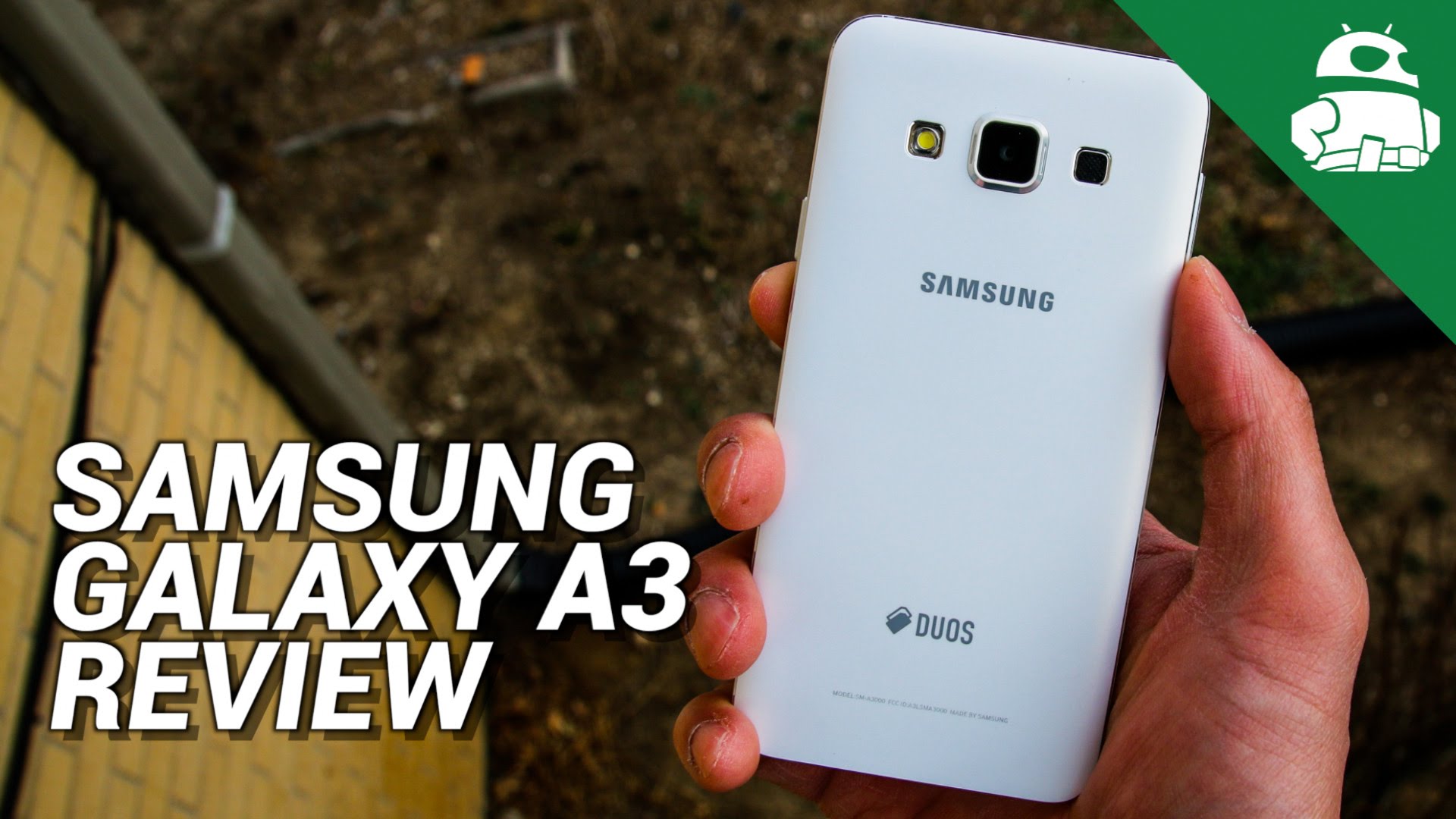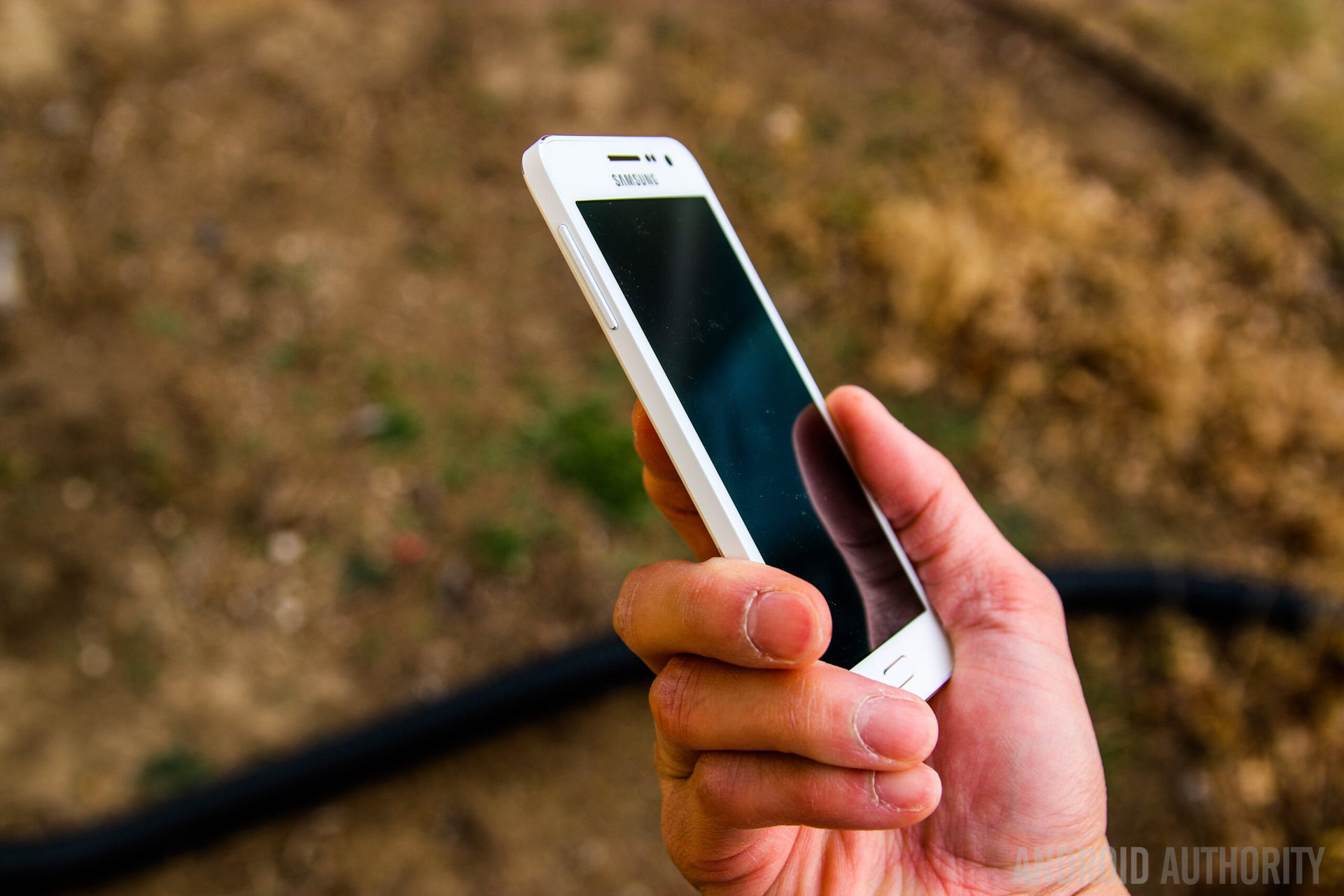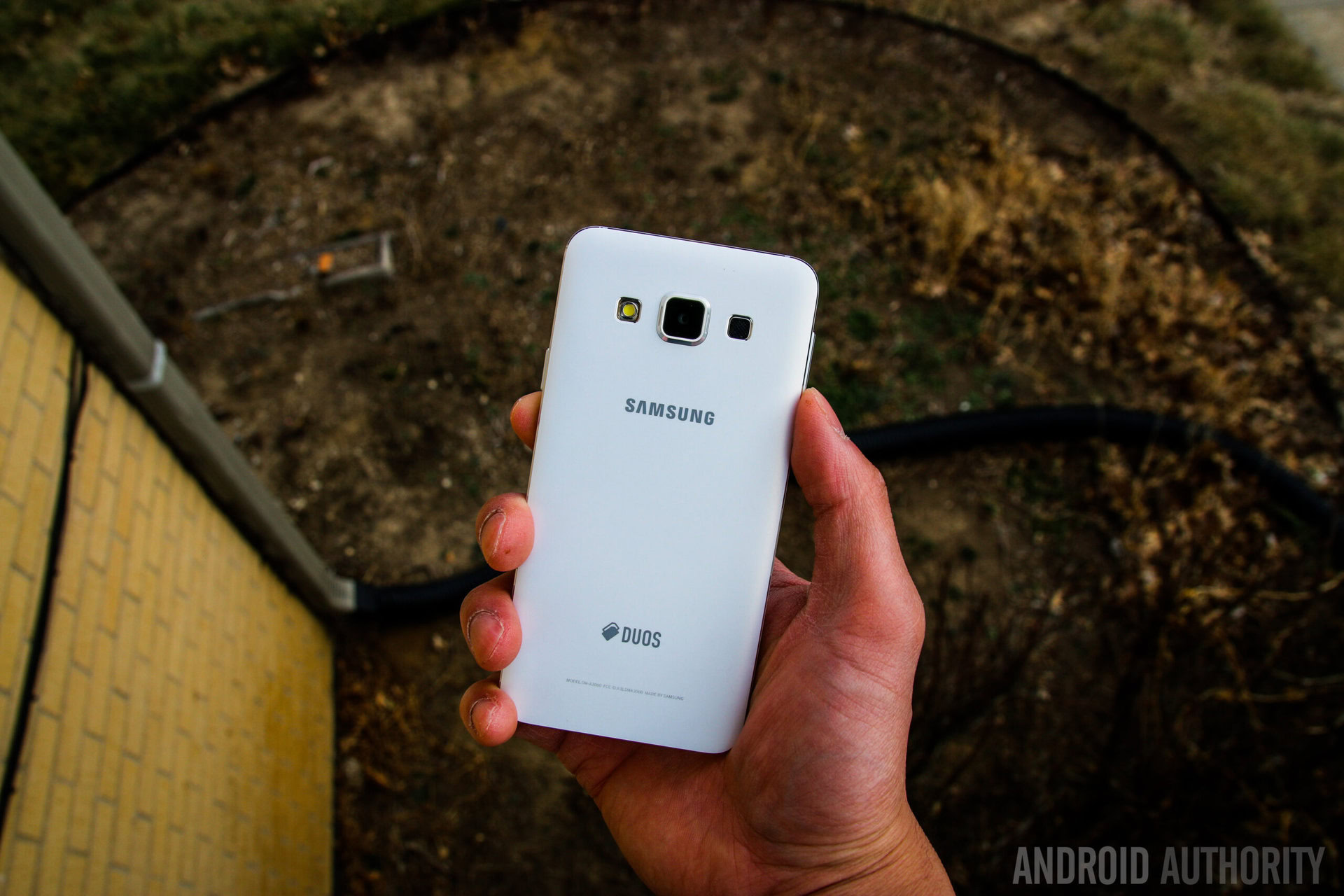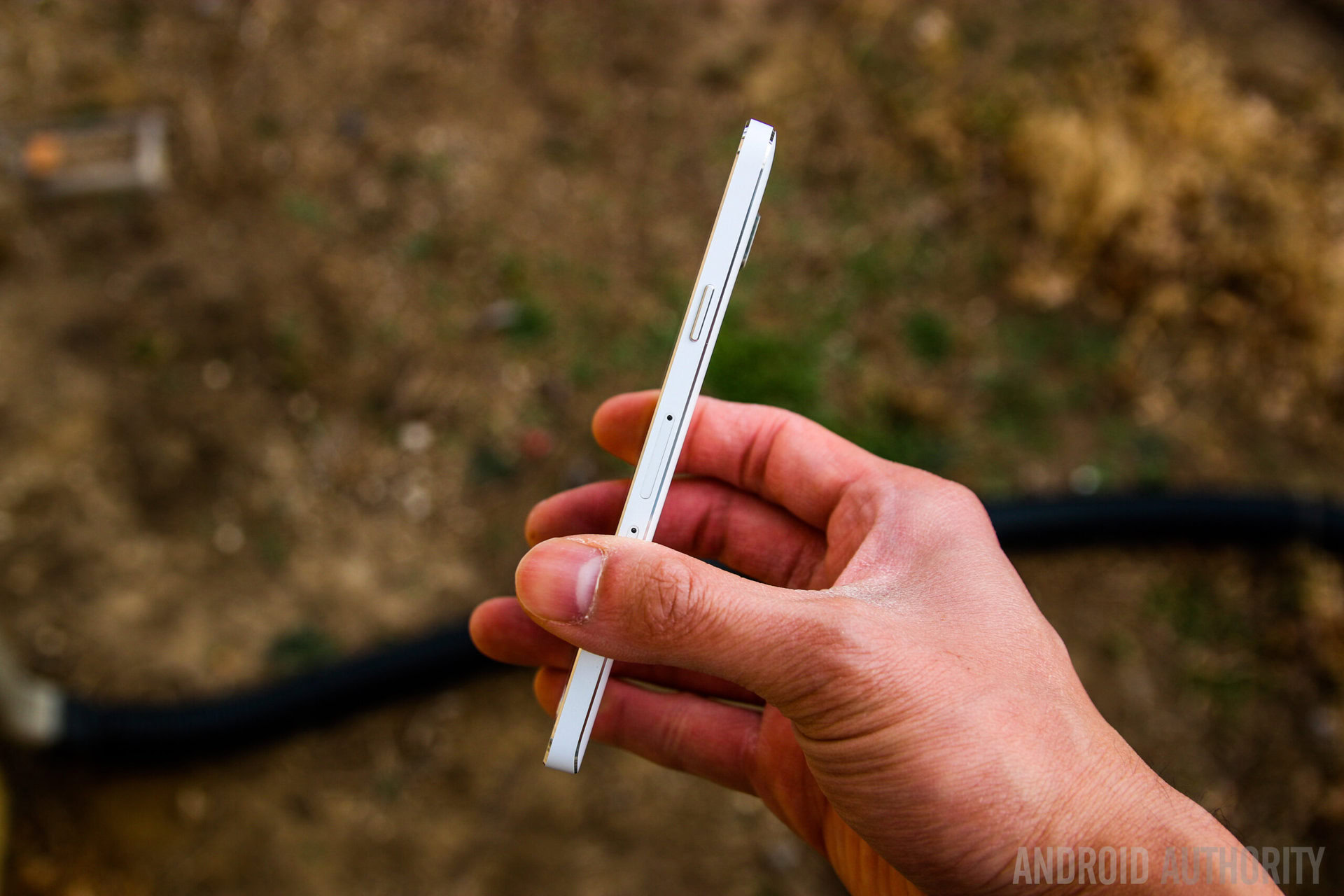Affiliate links on Android Authority may earn us a commission. Learn more.

Samsung Galaxy A3
What we like
What we don't like
Samsung Galaxy A3
With competing OEMs stepping up their game in terms of build quality, there have been a growing number of consumers that have been wanting Samsung to use a build material other than plastic. Samsung took a step in this direction with the Samsung Galaxy Alpha with its metal frame, which was also the design language found with the flagship Galaxy Note 4, with the back cover still plastic in both cases.
Related: Best Galaxy A3 cases
With their latest A series of smartphones though, Samsung took things in terms of build quality to another level, with the two otherwise mid-range devices boasting premium metal unibody designs. While neither of these smartphones are widely available in the US, their design language may serve as a precursor for what’s to come, as was true in the case of the Galaxy Alpha and the Galaxy Note 4, which is what has us very excited. We’ve already taken a closer look at the Galaxy A5, and today, we’ll be taking a look at its smaller sibling, in this in-depth review of the Samsung Galaxy A3!
Design
For many years, Samsung smartphones have been made entirely of plastic, and while this didn’t particularly affect durability, it did unfortunately result in expensive flagship smartphones not feeling as premium as they should be. With the Galaxy A3, as well as the Galaxy A5, Samsung has taken things in a different direction, with both devices featuring a full metal construction.

Even with the change in build material, the design aesthetics remain largely the same across the board, with signature Samsung elements returning with the Galaxy A3, including, but not limited to, the tactile home button up front, flanked by capacitive back and Recent Apps keys. In typical Samsung fashion, the easy to reach power button is found on the right side, with two SIM card slots found below it, with one of the slots also doubling as a microSD card slot. The volume rocker is to the left, with the headphone jack and the microUSB port found at the bottom. The rear camera is flanked by the LED flash on its left, with a single speaker found on the other side.

The way it feels in the hand however is drastically different from even a flagship device like the Galaxy S5. Despite its metal body and smooth back, the phone isn’t as slippery as one might expect, with the flat sides and chamfered edges providing plenty of grip. With its 4.5-inch display, one-handed use with the Galaxy A3 isn’t an issue, which is not something you can say with regards to a lot of current smartphones. The Galaxy A3 feels solid and looks great, serving as proof that Samsung is certainly capable of making premium feeling devices.
Display
As mentioned, the Samsung Galaxy A3 comes with a 4.5-inch Super AMOLED display with a 960 x 540 resolution, resulting in a pixel density of 245 ppi. AMOLED technology brings with it everything we love about it, including deep blacks, high contrast ratios, saturated colors, and wide viewing angles.
That said, while a 4.5-inch display size is great for one-handed use, it does seem a little small when it comes to media consumption. The low resolution doesn’t help either, especially when it comes to gaming or watching videos on Youtube. This display is great for everyday tasks such as browsing the web or social media, but does leave a lot to be desired from a media consumption standpoint.
Performance and Hardware
Under the hood, the Samsung Galaxy A3 packs a Qualcomm Snapdragon 410 processor, clocked at 1.2 GHz, and backed by the Adreno 306 GPU and 1 GB of RAM. This is Qualcomm’s updated 64-bit mid-tier processor, and while it seems like a modest package, it provides more than enough power to handle most tasks on the device, including some graphic-intensive games, without too many hiccups.

The only real issue that comes up is with the fact that the Galaxy A3 tends to refresh the home screen after playing a high-end game, or when spending a lot of time in the camera application. This is mostly likely because of the device featuring just 1 GB of RAM though, as this happens only after using apps that use a lot of memory, with the device performing really well otherwise.
The Galaxy A3 comes with 8 GB or 16 GB of internal storage, further expandable via microSD up to 64 GB, as well as a full suite of sensors and connectivity options, including LTE support. One thing to watch out for though is the version number, as various versions support varying LTE bands depending on the market, and this particular review unit was unable to connect to T-Mobile’s LTE network.
The single speaker can be found on the back, next to the camera unit. The speaker produces a clean sound, with no distortion, but doesn’t get especially loud, even when compared to single speaker setups on some other smartphones. The placement of the speaker does allow for a clear sound when holding the device in portrait orientation, but you may end up covering it when watching videos or playing games while in landscape orientation.
The Galaxy A3 is a small and compact phone, and that reflects in the rather small 1,900 mAh battery of the device. That said, the battery life is still very impressive, with 12 to 15 hours off the charger including 4 to 5 hours of screen-on time, even with a lot of gaming and watching videos on Youtube. The low resolution AMOLED display is certainly a contributing factor, but the battery life is still one of the highlights of this phone.
One factor that may disappoint die-hard Samsung fans is the fact that the battery is non-removable, a sacrifice that had to be made to accommodate the metal construction. Power saving features are available though, including the ultra power saving mode that switches the phone to a grey scale palette, but severely limits functionality, that should allow most users to get enough juice out of this battery.
Camera
When it comes to the camera, the Galaxy A3 features an 8 MP rear unit with LED flash, along with a 5 MP front-facing camera. The camera application hasn’t changed much from previous Samsung devices aesthetically, but isn’t as packed with features as before. Standard settings like exposure, ISO, and white balance are available, with the number of shooting modes slimmed down to include just beauty face, rear-cam selfie, continuous shot, and animated GIF, panorama, night mode, and HDR.
The picture quality is serviceable, but for the serious smartphone photographer, the camera is going to be a disappointment. Even in good lighting, there is a noticeable amount of noise and photos are soft and muddy with very little detail, becoming even more apparent in low light and night time photography. With a maximum ISO of only 800, low light shots will suffer, but the built-in night mode, and even HDR, can help improve the situation without resorting to using the flash. All said and done, the camera isn’t particularly impressive though.
Software
Finally in software, the Galaxy A3 runs Android 4.4 Kitkat, and of course, it wouldn’t be a Samsung device without the TouchWiz UI. A point of note is that while this may be TouchWiz aesthetically, it may not be the user interface you may be used to, with this iteration not sharing a whole lot in terms of features with the flagship Galaxy S5 and Galaxy Note 4. There is no multi-window, air gestures, smart stay, smart pause, or the pre-installed apps like chatON and S-Health to be found anywhere. Surprisingly, S-Voice is also missing.
The software experience is actually quite reminiscent of what was on the Galaxy S2, before TouchWiz became as cluttered and convoluted as it is today. It does feel like Samsung is taking a lot of steps to remove a lot of the redundancies they have created on top of Android, and this could very well be a preview of what is to come.
Specs
| CPU/GPU | 1.2GHz Quad-core |
|---|---|
Display | 4.5-inch, qHD |
RAM | 1GB |
Memory | 16GB, microSD up to 64GB |
Battery | 1900 mAh |
Camera | 8MP/5MP, AF with LED flash |
Connectivity | WiFi 802.11 a/b/g/n, A-GPS / GLONASS, NFC, Bluetooth® v 4.0 (BLE, ANT+) |
Network | 3G HSPA+ 42.2/5.76Mbps or 4G LTE Cat 4 150/50Mbps |
Sensors | Accelerometer, Geo-magnetic, RGB, Proximity, Hall Sensor |
OS | Android 4.4.4 KitKat with TouchWiz |
Dimensions | 130.1 x 65.5 x 6.9mm, 110.3g |
Colors | Pearl White, Midnight Black, Platinum Silver, Soft Pink, Light Blue and Champagne Gold |
Pricing and Final Thoughts
The Galaxy A3 isn’t available in the US from any network operator, but can be picked up from Amazon for $320. This is quite steep for a device with such specifications, especially when you consider the slew of budget-friendly options available that offer a similar experience, and sometimes better, if you can manage to get yourself an invite for the OnePlus One.
There you have it – a closer look at the Samsung Galaxy A3! Samsung is certainly stepping up in the build quality department once more with the A series lineup, and while the Galaxy A3 is not a flagship, it’s a very solid smartphone overall. That said, even with a build quality that rivals some of the top tier smartphones currently available, this device won’t satisfy the needs for users who want a smartphone at a higher performance level. If history is any indication though, we may be seeing this design aesthetic with an upcoming Samsung flagship very soon.